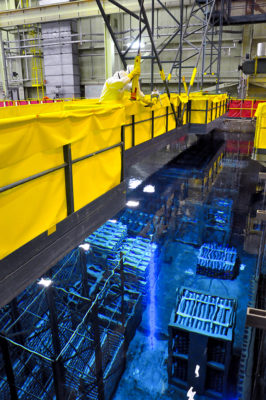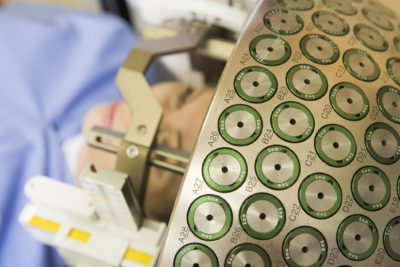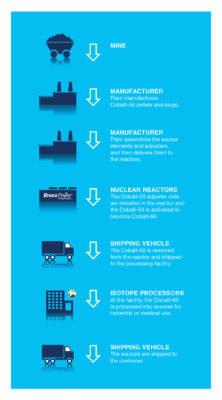
Hospitals in Canada and throughout the world recently averted a crisis many of us never even knew was looming. But anyone connected to nuclear medicine, whether technician, doctor or patient would have some idea of the impending scarcity of HSA Cobalt, the isotope that makes radiotherapy treatment of complex brain cancer possible.
This fall, the partnership announced in 2015 between Bruce Power and Nordion (a long-time supplier of medical grade Cobalt) to produce High Specific Activity (HSA) Cobalt in the four Bruce B reactors reached a milestone as teams began production of what will become a stable supply of HSA for decades to come.

CANADA WORLD’S TOP COBALT PRODUCER
For over 65 years – and for as long as radiotherapy has been a part of cancer treatment – Canada has been a leading producer of this radioactive isotope. As the nuclear reactor currently responsible for its production nears the end of its lifecycle, the medical community had little in the way of a solution to a problem that will continue to grow as people live longer and more populations present with cancer.
That’s why news of the first batch of a new supply of HSA Cobalt-60 going into production this fall was not only a welcome development in Canada’s nuclear energy industry but also a relief to cancer treatment centres around the world.
“Recognizing that in 18 months the NRU reactor will reach its end-of-life, it was critical to find another source of HSA for these life-saving operations,” explains Ian Downie, Nordion’s general manager of gamma technologies. “The HSA Cobalt produced by Bruce Power will help fill this gap.”
Indeed, Bruce Power’s CANDU reactors are vastly different than the National Research Universal (NRU) reactors at Chalk River, Ontario, that have been producing HSA for the last 60 years, explains Pierre Pilon, Senior Vice President of the Bruce B reactor.
“But we are looking at innovative ways like this to help with isotope production when NRU is shut down. And our engineering teams here have worked very hard to ensure there is absolutely no impact or changes in how we operate and maintain our units,” he says.
TEAMING UP TO FIND A SOLUTION
Nordion and Bruce Power have worked together for years producing Low Specific Activity Cobalt-60 for use in the sterilization of single-use medical devices and implantable devices as well as for food irradiation. In fact, it was this association that provided the basis for the two organizations to collaborate on a solution to address the HSA Cobalt problem.
“We were seeing ‘hotter’ LSA Cobalt coming out of Bruce so we looked at how – with some clever engineering – we could get HSA quality Cobalt,” explains Richard Wiens, Nordion’s director of strategic supply, gamma technologies.
“If we hadn’t done anything, two-thirds of the world’s supply [of HSA Cobalt-60] would have gone away. Possibly other suppliers could have ramped up supply but there’s no way they could have filled that gap.”

NEED FOR MORE RADIOTHERAPY MACHINES
By some estimates, HSA Cobalt-60 has been instrumental in treating 35 million cancer patients worldwide. It is particularly important for alternative treatments to traditional brain surgery and radiation therapy for the treatment of complex brain conditions through innovative machines like the Elektra Gamma Knife, which allows for the non-invasive, highly precise treatment of brain disorders.
The Gamma Knife uses gamma radiation to focus 200 microscopic beams of radiation on a tumour or other target. Although each individual beam has little effect on the brain tissue surrounding the tumour, where the beam intersects, a strong dose of radiation is delivered to the site, minimizing damage to healthy tissue and lowering side effects compared to traditional therapy in some cases.
At an event announcing the start of the new HSA supply’s production in October (the first batch is to be ready in early 2019), Dr. Mary Gospodarowicz, clinical department head at Princess Margaret Cancer Centre in Toronto spoke of the need for more radiotherapy equipment. The Gamma Knife and other Cobalt machines, she explained, are an essential part of cancer care.
“Much of what we hear about cancer research has to do with advancing our understanding of the molecular and genetic nature of the disease,” she said. “However, advances in technology for the diagnosis and treatment of the disease are equally important to having safer and more effective interventions.”
And that is indeed the hope expressed by Mike Rencheck, Bruce Power’s President and CEO who also spoke at the event.
 IMPORTANCE OF A RELIABLE COBALT SOURCE
IMPORTANCE OF A RELIABLE COBALT SOURCE
“As a long-time supplier of Cobalt-60, we have long been helping to keep our hospitals safe for our most vulnerable citizens,” he said. “Now, with HSA Cobalt being harvested from our Bruce B reactors, we will have a greater impact on human health across the globe.”
Kathryn McGarry, Ontario’s Minister of Natural Resources and Reza Moridi, Minister of Research, Innovation and Science, were also in attendance. While Moridi provided some context to the importance of this announcement for Canada’s nuclear industry, McGarry spoke of her perspective as a former critical care nurse.
“I remember many difficult discussions in the intensive care unit with physicians, specialist and family health teams about how we were going to manage when we may be short on nuclear medicine,” she said.
“With the partnership between these two Ontario companies announced today, patient can breathe easy knowing they have a secure, reliable source of HSA Cobalt to help families across this province and beyond with their healthcare needs.”


